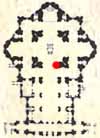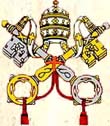 |
| Grottoes
Vatican City Colonnade Saints Floorplan #2 |
| Altars
Monuments The History |
| Related
Items St Peter-Square Altar of St Peter |
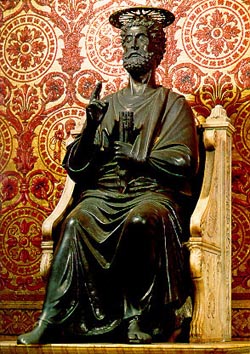 |
On this ancient bronze statue, St. Peter has his right toes worn down by centuries of pilgrims who traditionally touch the foot.
|
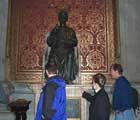 |
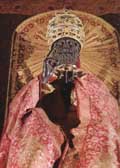 |
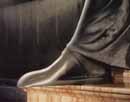 |
From: 'Guide to Saint Peter's Basilica'
This ancient statue of St. Peter, portrayed as he gives a blessing and
preaches, while holding the keys to the kingdom of heaven is famous throughout
the world. Some scholars have attributed it to Arnolfo di Cambio (1245-1302),
but others believe that it is a V century casting.
Pilgrims who come to the Basilica traditionally touch and kiss its foot, so that it is literally worn thin. In the Middle Ages pilgrims who reached Rome, touched and kissed the foot of the statue and prayed to St. Peter asking that he be merciful and open the gates of heaven for them if they died during the pilgrimage.
On 29 June, the feast of St. Peter, the statue is clothed with an amice, alb, tiara, stole, red cope and a ring so that it practically seems to come to life. Fine marble, Sicilian jasper, green porphyry and the "marble of St. Peter" decorate the pedestal.
Behind it, there is what seems to be a fine brocade draping, however, it is actually a mosaic. Above the baldachin, in a circular mosaic is a portrait of Pope Pius IX (1847-1878), the first Pope who in nineteen centuries reigned longer than St. Peter himself, who had led the church for twenty-five years. Pius IX sat on Peter's throne for thirty one.
From 'St. Peter's
Basilica - A Virtual Tour' by Our
Sunday Visitor
The famous bronze statue of St. Peter is placed against the pillar of
St. Longinus, above an alabaster base that was executed in 1757 by Carlo
Marchionni. In this statue St. Peter is seated on a marble see from the
early Renaissance, dressed with the philosophical stole, with his left
hand holding the keys close to his chest and the right raised in the act
of blessing. His right foot protrudes from the previously mentioned base,
which is worn by the kisses of the devout.
The identification of the author but also of its exact epoch, is a "vexata quaestio" which has yet to be resolved, with datings ranging between the fifth, or even fourth century and the 13th or 14th centuries. Tradition has it that the statue was commissioned by St. Leo the Great, as a token of gratitude for defeating Attila, and that it used the metal from the statue by Giove Capitolino. But, in reality, the oldest historical information about the work dates back only to the 15th century.
Currently, the almost unanimous opinion is that the Vatican bronze statue dates back to the late 13th century and more specifically to the restricted environment of Arnolfo di Cambio, the artist who created the tabernacles of St. Paul and St. Cecilia, and the sacellum of Bonifacius VIII in the Constantinian Basilica.
The archaic character of the statue of St. Peter sustains the attribution to Arnolfo di Cambio (ca. 1296) since the "antique" modules that are present, such as the so-called "snail" curls of the hair and the beard are found in famous Arnolfian works, matching the "13th century classicism," which was widespread in the European sculpture of the period.
In 1871, the mosaic altar frontal was placed behind the statue, imitating a brocatello drapery, and above a mosaic medallion with the portrait of Pius IX, in honor of being the first Pope whose papacy lasted more than 25 years, attributed to that of St. Peter and considered by tradition to be insuperable.
